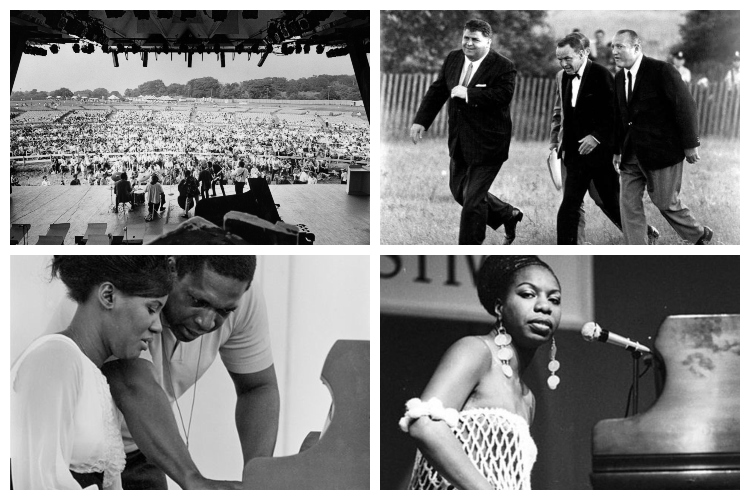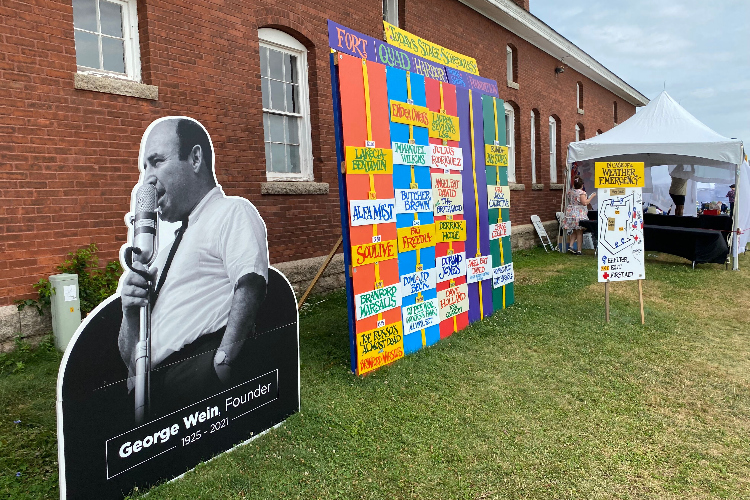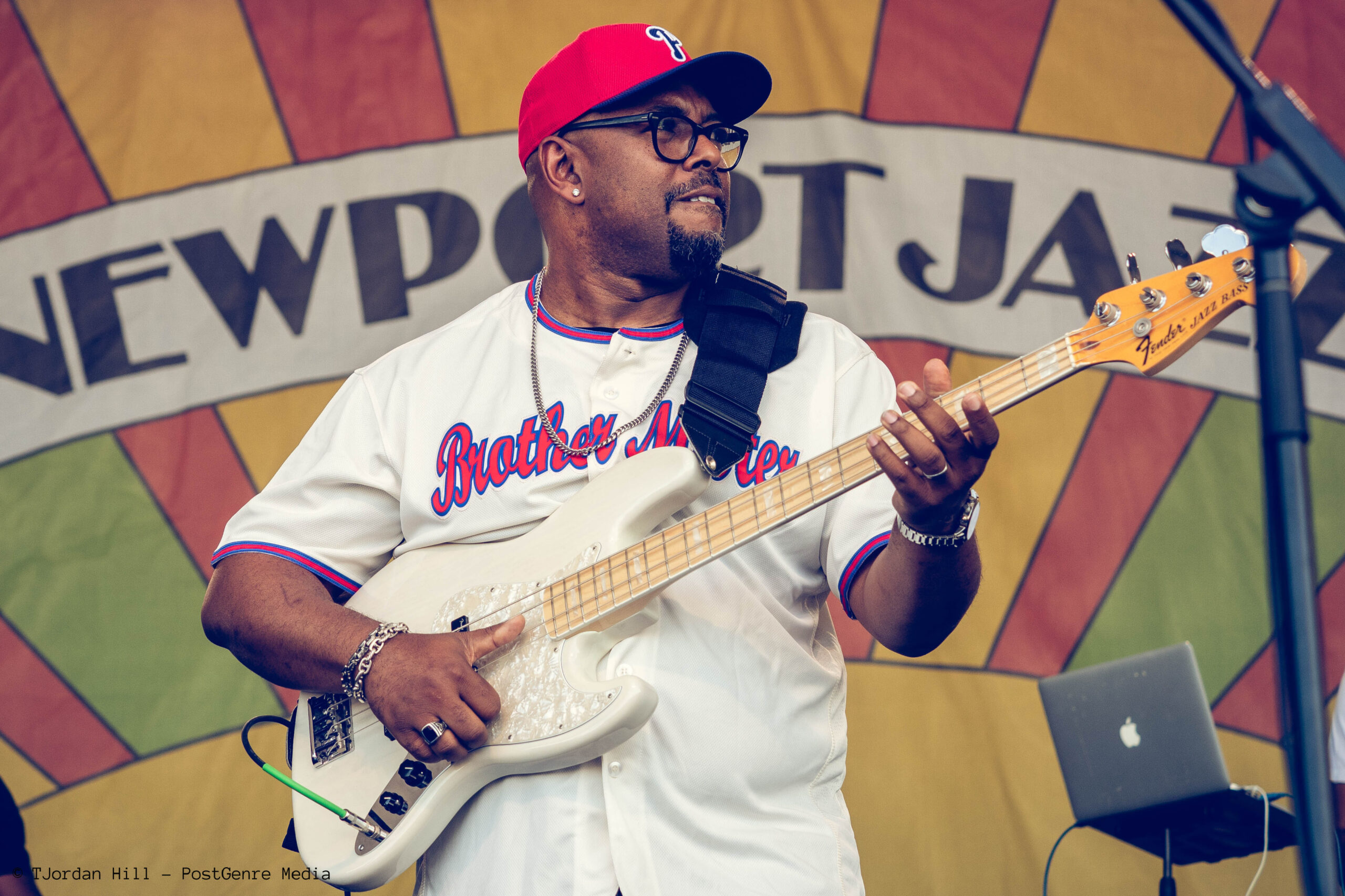A History of the Newport Jazz Festival – Chapter V: The New Thing, 1965-1968
|
Getting your Trinity Audio player ready...
|
Despite its rough shape, the new site was at a fantastic location. Near the JT Connell Highway, it had sufficient space for both a large stage – more than a third bigger than the prior one – and extensive audience seating. It also allowed for convenient parking, a frequent concern at Freebody Park due to its presence in the middle of a primarily residential area with narrow streets. The new venue was close to downtown yet still far enough away to avoid significant traffic congestion. But the Festival Productions team faced serious hurdles in turning it into a concert space. Even up to three weeks before the 1965 Jazz Festival, the property still reeked of dead fish left from its former life. But due to determination and perseverance, they turned it into Festival Field, a home befitting of both the Newport Festivals with four entrances on the main road. It even had a helicopter pad.
The inclusion of a landing spot sufficient for two choppers was a necessary logistical feature to accommodate the year’s scheduled headliner. Three weeks before Bob Dylan shocked the world by going electric at the Folk Festival, sold-out crowds at its sister celebrated Independence Day by seeing and hearing one of the most popular artists of all time: Frank Sinatra. Despite his role in a motion picture filmed in Newport and thematically centered around the Jazz Festival, High Society (Metro-Goldywn-Mayer, 1956), it was the singer’s first time at Wein’s event. Indeed, the producer initially did not believe he could even secure Old Blue Eyes’ appearance and reached out only as a fluke. It came at a peak in the vocalist/actor’s career as 1965 was as Billboard would call it, the “peak of his eminence.” Thus, the immense demand for tickets was unsurprising. Adding further to listeners’ ravenous appetites was the fact that Sinatra’s backing would be the group with which he recorded It Might as Well be Swing (Reprise, 1964) the preceding year: Count Basie and his Orchestra, conducted by Quincy Jones. In response, George Wein instituted a policy he never previously considered for his events. Anyone who planned to attend the Sunday night performance would be required to purchase a ticket to one of the other three days of the Festival. In many ways, this was more of a gift than a mandate as these other performances exposed many to sounds to which they may be less accustomed.
Thursday, July 1st, was programmed as “The Family of Jazz,” and established by Pete Seeger as a way of showing connections between musical styles. In addition to a set by Seeger himself, the evening included a duet between jump blues pianist Memphis Slim and bassist/guitarist/vocalist Willie Dixon, the Modern Jazz Quartet, Joe Williams, the Les McCann Trio, and George Wein’s Newport All-Stars. Dizzy Gillespie and James Moody pulled double duty. First, they appeared as special guests of Muddy Waters’ Blues Band with Otis Spann, James Cotton, and Little Bo. They reemerged with the trumpeter’s own group, featuring a young Kenny Barron on keys.
The next afternoon’s series titled “The New Thing in Jazz” was dedicated to the budding avant-garde scene. As early as 1958 the Festival showcased Cecil Taylor. And by 1963 it shared John Coltrane’s sheets of sound. However, this marked the first time it organized an entire program focused on the nascent art form. The Jazz Composer’s Orchestra with Mike Mantler, Carla Bley, Milford Graves, Jimmy Lyons, Ken McIntyre, Roswell Rudd, Walter Booker, and John Tchicai began the occasion. In what was later recorded as part of New Thing at Newport (Impulse! 1966) Archie Shepp’s Quartet featuring Bobby Hutcherson followed. Next was Paul Bley’s Trio with Steve Swallow and Barry Altschul then a return of Cecil Taylor, flanked by Bill Barron, Jimmy Lyons, Henry Grimes, and Andrew Cyrille. Although only a few hundred were in attendance, and even then many did not fully appreciate the music, it was an incredible opportunity for forward-thinking listeners.
Friday evening’s “Jazz for Moderns” included performances by Carmen McRae, Thelonious Monk, and Art Blakey’s Quintet with Gary Bartz and Lee Morgan. Miles Davis’ Second Great Quintet – Herbie Hancock, Wayne Shorter, Tony Williams, and Ron Carter- appeared a month before E.S.P. (Columbia, 1965). And John Coltrane, now rejoined by Elvin Jones, presented his Quartet after releasing A Love Supreme (Impulse! 1965) that past January. In place of a lecture, July 3rd brought a drum workshop with Louis Bellson, Art Blakey, Roy Haynes, Elvin Jones, Jo Jones, Joe Morello, and Buddy Rich. Across that day and the following, two pianists – Earl “Fatha” Hines and Abdullah Ibrahim (then known as “Dollar Brand”) made their Newport debut.
And then there was Sinatra. After flying to Providence, Rhode Island by private plane, he helicoptered to Festival Field, landing right behind the concert stage. A second followed loaded with Quincy Jones and several bodyguards. From the landing pad, the crew walked straight to the stage for their performance. An hour of primarily uptempo songs met with thunderous applause. It was the most well-attended Newport Festival to that time and proved that Festival Field was a capable new home for the summer event. However, this is not to say the evening was perfect. Some attendees decided to crash through a mile-long fence along the concert site’s perimeter and were met by police, foreshadowing future problems at the site.
After the success of the 1965 Festival, Wein made efforts to create a year-round permanent home on the 104 acre Coggeshall Farm in neighboring Middletown with hopes of turning the region into a major artistic cultural center for years to come. However, these dreams were dashed after a less receptive town council voted against approving a required zoning request. The Festivals were to remain at their home off of JT Connell.
By 1966, the avant-garde scene previewed the prior year only further cemented itself as a fixture of artistic expression with the release of works like Coltrane’s Ascension (Impulse! 1966), Taylor’s Unit Structures (Blue Note, 1966) and Conquistador! (Blue Note, 1966), Don Cherry’s Symphony for Improvisers (Blue Note, 1966), and Roscoe Mitchell’s Sound (Delmark, 1966). Unsurprisingly, this led to the further representation of the approach at that summer’s Festival. Shepp closed Friday, July 1st with his group featuring Rudd. The next day Bill Dixon presented his Quartet with dancer Judith Dunn. ‘Trane was a particularly prominent force. By this time, he continued to expand outward, moving beyond his classic Quartet. Though still working with bassist Jimmy Garrison, Alice Coltrane, Pharoah Sanders, and Rashied Ali supplanted the rest of the group in following the leader to unexplored sonic universes. At Newport, they would produce an incredibly powerful statement that could be formed by only some of the most creative minds of the Twentieth Century. Unfortunately, the event also marked the beginning of the final year of the saxophonist’s life; he would pass away the following July.
The 1966 Festival also hosted a memorable trumpet and guitar workshop with Bobby Hackett, Clark Terry, Ruby Braff, Henry “Red” Allen, Dizzy Gillespie, Charlie Byrd, Kenny Burrell, and a new face, George Benson. Byrd additionally performed with his trio.
Miles Davis further experimented with his new Quintet on pieces like “Gingerbread Boy,” which would be released the following year on Miles Smiles (Columbia, 1967). Charles Lloyd’s Quartet presented three artists who, along with the saxophonist, would play a significant role in the future of music: Keith Jarrett, Cecil McBee, and Jack Dejohnette. The year after her rendition of “I Put a Spell On You” rose in the charts, Nina Simone wowed the audience. Another vocal icon, Ella Fitzgerald, sang with the Duke Ellington Orchestra. And there was a tribute to Woody Herman featuring his Orchestra and special guests Stan Getz, Al Cohn, Zoot Sims, and Gerry Mulligan. There was also a surprise guest appearance by Tony Bennett. The 1966 Festival was yet another success, breaking prior attendance records even without Sinatra.
While prior Festivals included artists from around the world, cross-cultural communication was a centerpiece of the 1967 Festival. Herbie Mann, who had long merged jazz with world music, shared the stage with Roy Ayers, Reggie Workman, Bruno Carr on drums, and Chick Ganimian on oud. Joining him were special guests Hungarian guitarist Gabor Szabo, German trombonist Albert Mangelsdorf, and Nigerian percussionist Babatunde Olatunji. Dizzy Gillespie, who often melded jazz with African and Latin rhythms, joined as well. Olatunji had his own set, as did German clarinetist Rolf Kuhn. Japanese bandleader Nobuo Hara appeared with his eighteen piece orchestra, the Sharps and Flats. But the global emphasis was best shown by Saturday, July 1st’s “Five Faces of Jazz” where Mann, Gillespie, Olatunji, Szabo, and guitarist Luis Enrique forged a cross-cultural dialogue by showing the influence of different cultures on jazz.
Other sets included Albert Ayler, Gary Burton’s Quintet with Larry Coryell, and returns of both Miles Davis with his Second Great Quintet and Nina Simone. There was a multi-generational vibraphone workshop – the first of its kind- with Milt Jackson, Gary Burton, Lionel Hampton, Red Norvo, and Bobby Hutcherson. The year also marked the first time any music festival had utilized a corporate sponsor, in this case, the Joseph Schlitz Brewing Company.
The partnership with Schlitz would prove fruitful to the future of the Festival. By 1968, the relationship spawned a twenty-one city “Salute to Jazz” tour. With the nation increasingly mired in Vietnam, it provided some relief to Americans from the calamities they saw daily in the news.
The sponsor would also make possible a Tribute to Big Bands at that summer’s Jazz Festival. The program included some of the best large ensembles of all time. The bands of Woody Herman and Count Basie began. A special New Dizzy Gillespie Orchestra would close with special guests Charlie Barnet, Benny Carter, Erskine Hawkins, Jack Leonard, Bob Eberly, and Joe Thomas. In the middle was the bandleader who brought crowds to a dancing fury twelve years earlier, Duke Ellington.
Approaching his 70th birthday, the performance came only a year after Ellington’s Orchestra’s composer-arranger Billy Strayhorn succumbed to cancer. The two men were very close. As Ellington put it, “Billy Strayhorn was my right arm, my left arm, all the eyes in the back of my head, my brain waves in his head, and his in mine.” But even in a time of sorrow, the bandleader could not avoid impressing audiences with his energy.
The remainder of the 1968 Newport Jazz Festival’s lineup was diverse. Rufus Harley showed that even the bagpipes could be a tool of improvisation. Saxophonist Vi Redd broke gender barriers as one of the first female horn players to lead her own group at Newport. Mongo Santamaria- in his first appearance at the Festival- blended pachanga, boogaloo, salsa, and jazz. Hugh Masekela, like Abdullah Ibrahim a few years prior, shared a glimpse of the South African jazz scene. Dionne Warwick provided her vocals.
But even the most ardent Newport Jazz Festival fans could not predict the eclecticism that would come in 1969.
It is also available on demand.
Significant portions of this chapter were adapted from George Wein’s autobiography (written with Nate Chinen) ‘Myself Among Others’ (Da Capo Press, 2004), and ‘50: The Newport Jazz Festival, 1954-2004’.



